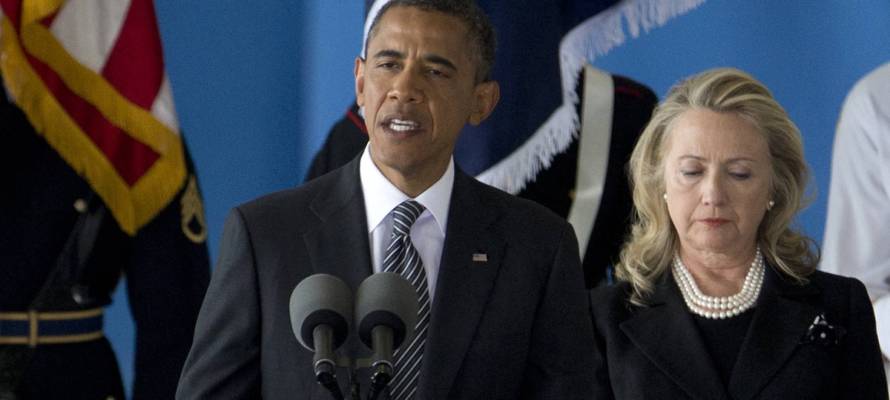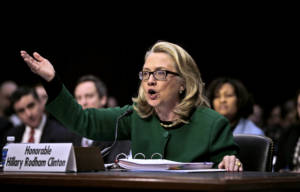
Former Secretary of State Hillary Rodham Clinton testifies on Capitol Hill. (AP/Pablo Martinez Monsivais)
After more than two years, Republicans delivered a final Benghazi Committee report that ripped the Obama administration’s handling of the 2012 terrorist attack — but Hillary Clinton’s presidential campaign dismissed the findings as ‘discredited’ conspiracy theories.
The 800-page report was released on Tuesday, and marks the culmination of an investigation that has haunted the 2016 Democratic front-runner on the campaign trail, even as Clinton’s campaign has consistently slammed the probe as a political vendetta. But for all the partisan battling over the probe, the panel’s final report — in keeping with Chairman Trey Gowdy’s prior statements — offered new details of the attack and the nation’s response but didn’t focus on Clinton in particular.
Instead, the report drilled down on new details about how Clinton’s State Department failed to protect the diplomatic outpost in Libya. The report also said that the CIA missed the looming threat despite warnings and wrote faulty intelligence reports after the attack. And GOP staff said their findings indicate that the Defense Department did not meet its response times to deploy military assets to Benghazi and follow-up to ensure Americans were rescued in a timely fashion.
The report includes new specifics about a US teleconference convened by White House chief of staff Denis McDonough during the attack. According to the report, some participants on the video conference were unsure about what each agency was doing to rescue Americans.
State Department officials on the call also brought up concerns about whether Marines who might have been deployed to Benghazi were wearing uniforms, the report found — something officials previously said could hurt diplomacy in the region. One commander told the committee he and his men over the course of three hours kept having to change from uniforms to civilian clothes.
The military never deployed to Benghazi.
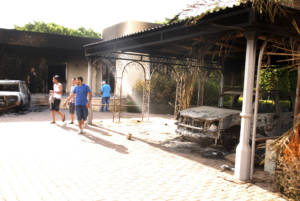
Libyans walk on the grounds of the gutted US consulate in Benghazi, Libya, after an attack that killed four Americans, including Ambassador Chris Stevens. (AP/Ibrahim Alaguri)
For her part, Clinton said she would “leave it to others to characterize this report but I think it is pretty clear it is time to move on.”
“And I said this when I testified for 11 hours that no one has thought more about or lost more sleep over the lives that we lost, the four Americans, which was devastating. And we owe to those brave Americans that we make sure we learn the right lessons from this tragedy,” Clinton said in Denver.
Earlier, Brian Fallon, spokesman for the Clinton campaign, was far more direct, dismissing the report as a rehash of “discredited” “conspiracy theories.”
“After more than two years and more than $7 million in taxpayer funds, the Committee report has not found anything to contradict the conclusions of the multiple, earlier investigations,” Fallon added. “This report just confirms what Majority Leader Kevin McCarthy and even one of Trey Gowdy’s own former staffers admitted months ago: this Committee’s chief goal is to politicize the deaths of four brave Americans in order to try to attack the Obama administration and hurt Hillary Clinton’s campaign.”
Ultimately, the report’s findings are unlikely to change the political narratives surrounding the attack. Republicans will surely use it to redouble their attacks on Clinton’s leadership while Democrats, who released a rebuttal Monday, continue to dismiss the whole process as a political charade.
Still, the report itself does not focus on the former secretary of state — as Gowdy has insisted it wouldn’t. Rather, the document offers a chronology of the events of the attack and new information gathered from interviews with more than 100 government officials and thousands of pages of documents, according to the document as well as interviews with sources familiar with the report.
In fact, two conservatives on the panel — Reps. Jim Jordan (R-Ohio) and Mike Pompeo (R-Kans.) — don’t feel the report goes far enough to criticize Clinton and the administration. They released their own addition to the report on Tuesday morning that said specifically Clinton “failed to lead” and the administration “misled the public” because of the upcoming presidential election.
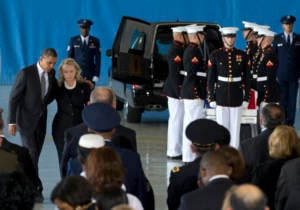
President Barack Obama and then-Secretary of State Hillary Clinton during the Transfer of Remains Ceremony at Andrews Air Force Base, Md., marking the return to the US of the remains of the four Americans killed in Libya. (AP/Carolyn Kaster)
But the final section of Gowdy’s report does sharply criticize both Clinton’s use of a private email account and what it called the administration’s “shameful” stonewalling of the investigation. The report said the administration’s refusal to turn over all records to the panel made it impossible for committee investigators to say with certainty that they have reviewed all the facts surrounding the Sept. 11, 2012, attack on the US mission in Benghazi that left four Americans dead, including Ambassador Chris Stevens.
“What may appear at first blush to be a lack of competence on behalf of the State Department now appears fully intentional and coordinated,” according to an exclusive copy of a part of the report that alleges the administration stonewalled Gowdy’s probe. “Delaying the production of documents sought by letter, informal request or subpoena has decided political advantages for those opposing the investigation.”
The State Department said it has done everything in its power to prevent future attacks.
“The essential facts surrounding the 2012 attacks in Benghazi have been known for some time,” State Department Deputy Spokesperson Mark Toner said in a statement. “There have been numerous reviews into this matter… Furthermore, within weeks of the attacks, the State Department and the Department of Defense worked together to dispatch Interagency Security Assessment Teams (ISATs) to assess the security posture of numerous high-threat posts. We have made great progress towards making our posts safer since 2012.”
The final report will offer the most detailed account to date of how four Americans were killed in Benghazi and the fallout, including why no DOD assets moved to help them until well after the attack had begun.
For example, the final report digs into allegations that the US was delivering or overseeing the transfer of weapons to Libyan rebels. The panel spoke to at least one individual who raised the possibility that the US was overseeing some sort of weapons shipping. Multiple news reports in the past year have cited unnamed State or intelligence officials saying the president approved a covert operation to ship weapons to Libyans to arm rebels trying to oust Libyan dictator Muammar Qadhafi — a proposal Clinton herself supported but that the administration has never acknowledged.
But the Benghazi Committee could neither confirm nor disprove those reports because the National Security Council would not allow CIA personnel or any officials across any agency, at any level, to answer committee questions about potential US involvement with weapons being shipped to Libyans, the report says.
“Over the course of nearly a dozen interviews with the State Department, the Defense Department and CIA personnel, witnesses consistently refused to answer questions related to certain allegations with respect to US activity in Libya even though the House specifically gave the committee access to materials relating to intelligence sources and methods,” the report reads. “Most of these questions related in some way to allegations regarding weapons.”
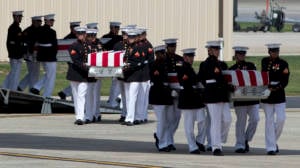
US military personnel move flag-draped coffins containing remains of Americans killed in Benghazi, Libya. (AP/Carolyn Kaster)
The report will also detail the Defense Department’s failure to move assets to respond during the attack. The panel found that while President Barack Obama and then-Defense Secretary Leon Panetta approved the military to do all that it could just after 8:30 that night, no one was deployed for hours and DOD failed to meet deployment times, according to one committee staffer.
While the administration has said it was beefing up security for Americans the day before the Sept. 11 attack, a GOP aide criticized the military for having some of their rescue jets locked up in training missions or with maintenance issues rather than ready to deploy.
The Defense Department has consistently said it couldn’t have gotten to Benghazi in time to save Americans. The panel says, however, DOD should have tried because it didn’t know at that moment when the final wave of attacks would end. One staffer said that had the attack lasted just an hour or two longer, the Defense Department might have been able to respond.
The military, the committee staffer said, didn’t deploy until after the Libyans had stepped in to save and evacuate Americans to Tripoli, which happened sometime around 6 a.m. Libya time, the panel says. And even then, the military went to Tripoli, never Benghazi.
The report will also discuss some previously undisclosed details of a 7:30 p.m. White House-hosted teleconference that included various agencies while the attack was underway in Libya. Clinton joined the call, too, but according to committee sources, much of the discussion centered on how and why the attack happened rather than how to get Americans to safety.
Panel Democrats said witnesses told investigators that the overall focus of the teleconference was first and foremost the safety and security of US personnel in Benghazi. Adm. Kurt Tidd, director for operations at the joint staff at the Pentagon, said they “went down the list of the types of forces that are potentially available.”
“[W]e came out of that meeting with basically: send everything,” he said.
But GOP sources said that urgency to ensure help was moving on the ground was not reflected in notes and action items. Half of the action items that conference participants wrote down in their notes had nothing to do with rescuing Americans, they said. Many of the action items were about the anti-Islamic video on which the administration would incorrectly blame the attack.
And at least one top official, Vice Chairman of the Joint Chiefs James Winnefeld, wasn’t there because he “had left to return to his residence to host a dinner party for foreign dignitaries.”
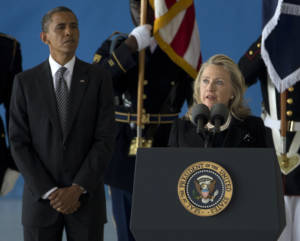
Secretary of State Hillary Rodham Clinton, accompanied by President Obama, speaks during the ceremony. (AP/Carolyn Kaster)
The panel also found that former senior officials in the defunct Qadhafi regime helped evacuate Americans to safety, a surprising finding given that the U.S. was backing the rebels fighting against the regime. The GOP committee staffer noted that the rebel forces State had worked to befriend did not come to the Americans’ aid.
The report will also dig into the flawed talking points the administration used after the attack, in which top officials like Susan Rice blamed the attack on a protest against an anti-Islamic video. The panel, speaking to those on the ground as well as those who flew drones over the region the night of the attack, said no one on the ground ever thought a video had anything to do with what happened that night.
The committee also learned from lower-level CIA officials that the intelligence agency report from that day was essentially flawed. Line analysts whom the intelligence committee had tried to bar from panel interviews eventually came in and admitted to the committee they made mistakes that day, surprising investigators. For example, they wrote the word “protest” in the headline of their intelligence assessment — but there was no evidence in their actual analysis to suggest a protest had occurred.
A committee official also told Politico the line analysts had relied on social media and news reports instead of what people on the ground were saying that day.
The committee also blasts the State Department’s internal investigation of the attack, known as the Accountability Review Board, for allegedly coordinating with Clinton’s chief of staff, Cheryl Mills. Such reviews are traditionally independent.
The committee spoke to at least one State Department official who said the traditional setup of an ARB was not followed, noting Mills’ involvement. And according to the ARB section of the committee’s report given exclusively to Politico, employees testified that Mills selected many of the ARB members, oversaw or was involved in document production to the ARB, had to approve the ARB’s talking to at least one senior State official and ultimately “shaped the ARB’s outcome with edits to the draft final report.”
By: Politico
